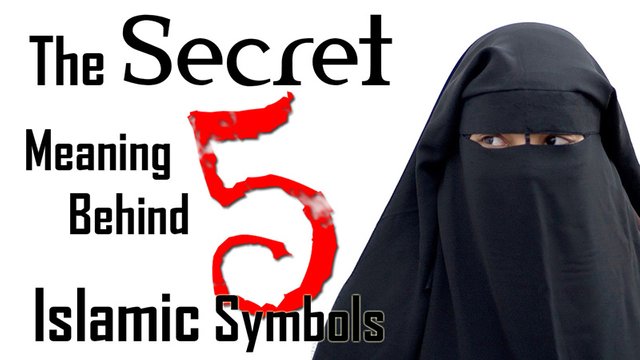
"In a symbol, there is concealment and yet revelation: here therefore, by silence and by speech acting together, comes a double significance." - Thomas Carlyle
The Nature of Symbols
In the previous article, I noted that objective reality is the basis of all language. Each word acts as a symbol for components of reality. These break down in to primary parts of speech like nouns for objects, verbs for actions, adjectives for properties, and prepositions for relationships. The sound that we recognize as a word is a symbol for the part of speech that we associate with it. The purpose of a symbol is to convey information that does not naturally reside in the symbol itself.
If I were rent a dumpster and pay you to clean out my basement while I'm on vacation, chances are I'd have a pretty clean basement when I got home. The chances are also pretty good that some things got thrown out that I didn't want thrown away. That box of baseball trophies for example or the stomping Jurassic Park T-Rex toy I've had for 20 years. When you see those things, all you see is junk that's taking up space. When I see those things, I see my childhood; the sights, the sounds, the people. Those things have deep meaning to me. One glance at the rubber dino and I'm a kid again. Trash to you. Treasure to me. The only difference is in the meaning and it can be anything, positive or negative, but whatever it is completely changes the nature of the object by changing how people react to it. That's the power of symbol.
The real power is shown when it means something to a lot of people. Companies, religions, and nations all use symbols to distinguish themselves. This is a very ancient form of communication that predates written language. The interesting part is that it didn't have to be invented. We naturally give meaning to things even if we're not aware of it. Association is everything to the human mind. It's the foundation of all communication. It turns out that not only do we naturally imbue significance to things, but when it comes to certain objects, human beings as a whole naturally imbue the same general meanings to those objects regardless of your personal memories, language or where you live. Whether you were raised in the Amazon or Beijing, certain symbols will have the same meaning to everybody even if they've never seen them before. Psychologist Carl Jung called these primal figures, shapes and ideas - archetypes.
Archetype: a very typical example of a certain person or thing
The essence of an archetype is UNIVERSALITY. No matter where you go, it has the same meaning.
One example of this is a circle which can represent the sun or moon. Another is a spiral which can represent time or motion. Another is a dome which can represent a hill or a breast. Another is the rod which can represent a tree or the male phallus. There are hundreds if not thousands of these archetypal symbols. They are the very essence of a thing that people can relate to.
The primordial image, or archetype, is a figure--be it a daemon, a human being, or a process--that constantly recurs in the course of history and appears wherever creative fantasy is freely expressed. Essentially, therefore, it is a mythological figure. . . . In each of these images there is a little piece of human psychology and human fate, a remnant of the joys and sorrows that have been repeated countless times in our ancestral history. . . . - Carl Jung
So when we see archetypes in the symbolism of big groups like religions, governments, etc, we automatically know they are trying to tell us something very fundamental about themselves - whether they are doing it consciously or not. It is certain that we will recognize them, at least superficially, but because of overexposure or distractions, we may not bother to really look close enough to interpret what is being said.

I've been familiar with Jung's work a long time and studied the Occult so when I read the Quran and the Sira and studied the Hadith and really got to understand Islam, these prominent Islamic symbols that we've all seen started to take on a whole new meaning. I certainly don't look at them the same anymore.
Women in Islam
In my first article, I explained the historical origins, fundamental tenants, and cultural impact of the ideology. Islam is not just a religion, but a sociopolitical way of life. A person's physical appearance, social conduct, diet and just about every other aspect of life is constrained by Sharia Law. Non-Muslims are not bound by these constraints. We can do what we choose as long as no harm is done to others. If I were to violate another person, I would be subject to a public justice system and a punishment deemed equal to the crime would be administered. That's basically true in Islam, but the difference lies in the the constraints and the methods of punishment. These can include, amputation, lashes, crucifixion, stoning, flogging or a tax known as the jizya (traditionally reserved for kafir or non-believers, a mafia like extortion). Although Sharia applies to all Muslims, women are particularly affected. It's estimated that 93% of the 20,000 Muslims killed each year for not following the arbitrary dictates of Muhammad, are women. These death sentences are administered for acts of blasphemy, homosexuality, treason, murder, adultery and banditry. In Muslim society, women are not equal to men sexually, legally, or materially. Many articles and books have been written that address how women are treated in Islam. Suffice to say, it's not good. So female subjugation is not an exception in Islam, it's the rule. In fact, it's the law.
Symbol # 1: Mosque and the Minaret
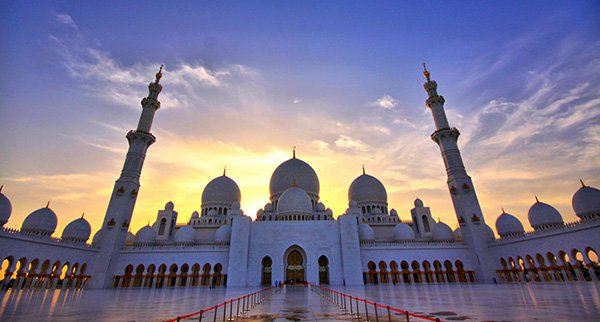
Imagery and architecture is central to Islam. From the smooth sloping domes and imposing minarets of the Mosque, to the prominent crescent and star, the symbols of Islam convey simplicity and power. Muhammad was the first to conceive of the Mosque and was involved in the construction. Within decades of his death, many places of worship started to appear where Muslims could congregate for salat or prayer - lead by the local Imam(Islamic worship leader). In addition, it can also act as a school, courthouse, and community center. This particular design became popular during the Mughal Empire in between 1500-1600 ad.
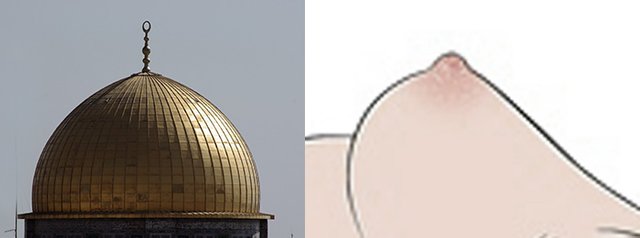
For obvious reasons, the dome or hill is one of the primary feminine archetypes.
Also known as the primordial mound, this symbol is one of the most ancient we know of. It's origins are tied to the widespread myth of a global cataclysm that occurred around 10,000 years ago. It's said the earth shook, the sky fell, and the oceans ran over the land. Highlands and mountain tops were islands of refuge and became sacred places to the survivors. They acted as a safe haven, a loving mother in a time of chaos and death. The cataclysm is a topic I will be returning to in the future as it plays a major role in human history.
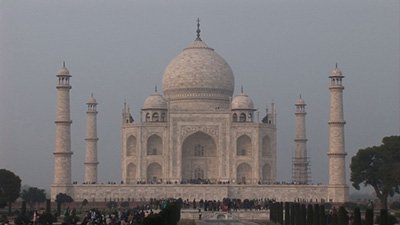
In traditional mosque architecture, the dome is surrounded by four minarets at the corners of a large square.
The female mother symbol is typically surrounded by what can be said is four archetypal male phallic symbols. It doesn't take a stretch of the imagination to see why. The shaft and the glans of the penis are clearly demarcated by the architecture. The components of the structure are even described in terms of base and shaft with the tops being conical or onion shaped. I'll save the anatomical side by side comparison. You get the picture.
s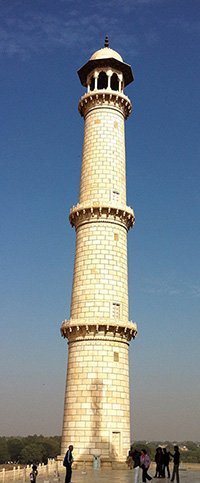
The top of the minaret is usually the highest point in mosques that have one, and often the highest point in the immediate area. They are used as a place where Muslims are called to prayer.
Interpreting these symbols is pretty straightforward. The dome represents the feminine essence at the center of the complex and the phallic minarets represent the masculine essence. When I say essence, I'm talking about natural qualities that are inherent to each gender that distinguish them from one another. This configuration of the female at the center would normally indicate a positive representation; the feminine focused at the at the center, lofted high upon stone walls to a position of importance. Unfortunately, due to what we know about how Islamic culture treats women, coupled with this complimentary symbolism, this isn't what is being conveyed here. In a traditional Mosque, the dome itself is usually topped with a rod or spike which is in turn topped with the crescent and star symbol. The first thing that came to mind when I noticed this was a stake through the breast. Granted, I've come to see things through a symbolic lens(some may interpret this differently), but I think this is an important observation because the dome is such a powerful representation of love(the loving mother), the primary feminine quality. A stake through the breast is akin to a stake through the bosom or chest, another way of saying a stake through the heart. Since the heart is the symbol of life and love, the spike upon the breast can be interpreted as the murder of love.
Domes top many buildings around the world like the Capitol Building in Washington, D.C. It's true that some domes don't have anything at the apex, but that one is topped with the Statue of Freedom; a Masonic symbol of an ancient female goddess sometimes referred to as Isis, Diana, or Athena (another sacred mother symbol). A feminine statue symbol atop another feminine symbol can be seen as a celebration of the sacred feminine. A spike, not so much.
Symbol # 2: Crescent and Star
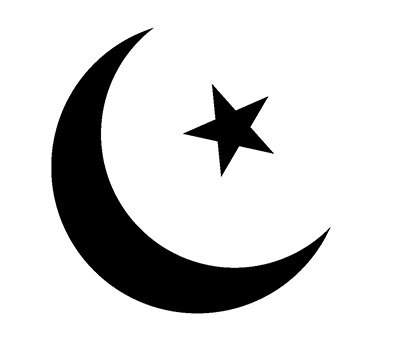
The sun has long been a symbol of power and masculinity and the moon a symbol of fertility and femininity. Although these are nonliving bodies as we define life, they have remarkably similar traits to the respective genders.
Traditional Masculine Traits:
Independent, Non-Emotional, Aggressive, Rough-Skinned, competitive, experienced, strong, active, confident, hard, sexually dominating, rebellious
-Solar Properties:
The sun is explosive, it radiates, it pulls, it moves the planets, heats the world, drives the cycles of life, illuminates, dominates the sky in size and energy, potentially destructive, harsh
Traditional Feminine Traits:
Dependent, Emotional, Passive, Sensitive, Quiet, Graceful, Innocent, Weak, Flirtatious, Nurturing, Self Critical, Soft, Sexually Submissive, Accepting
-Lunar Properties:
Gravitational passivity, reflective(sunlight), soft light, pleasing to the eye, guides the tides
We can also note that a woman's period seems to parallel the lunar cycle. A woman's cycle can range between 25 to 34 days. The lunar cycle is 28 days.
The crescent with a star(s) is another ancient symbol. This particular configuration was adopted by the Ottoman Turks in the 19th century. It became the universal symbol of Islam by the mid 20th century.
When you analyze the crescent and the star, the star is the center of the invisible circle that is eclipsing the moon. The moon is being hidden from the observer by the dominate object in the foreground, in this case a star(SUN). Using the sun as the sole masculine symbol would work well, but it would not tell the full story. An eclipse is necessary to reveal the deeper meaning which I am implying here; female subjugation.
In a normal solar eclipse, the moon passes between the earth and sun. The primary symbol of Islam is the star or sun passing in front of the moon. It's a reversal of the natural order. Symbolic reversals are widely used in Satanism. The inverted pentagram is the best known example.
The symbol can be interpreted as male dominance; violence above love, destruction above creation, and action without care. Suppression or absence of care is the very definition of psychopathy. Muhammad's way of life exemplified this perfectly. It's unfortunate that his example has been mimicked over the past 1400 years, but it is alive and well in the true followers of the prophet today.
These next three symbols are variations of the two above, but are just as important.
Symbol # 3: Burqa
The Burqa is an outer garment worn by women in some Islamic communities to cover their bodies when in public. There is a rectangular mesh in front of the eyes and the cloth extends from there down to the ground completely covering the body. Muslims who adhere to this practice are forbidden by law to wear anything else. Women in the modern day have been stoned to death for not wearing the sacred veil. The Hijab(face exposed) and Niqab(eyes exposed) serve the same function but reveal more of the face. Hands and feet may be exposed as well.
Like the crescent and star symbol, the burqa is another example of masculine dominance run wild in Islam. The physical being of a woman is very literally hidden from the world and she is stripped of her feminine identity. I see this as an extension of the crescent and star symbolism. A masculine force blotting out or occulting the feminine.
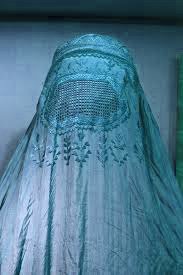
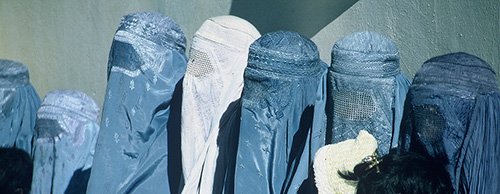
Symbol # 4: Rub el Hizb
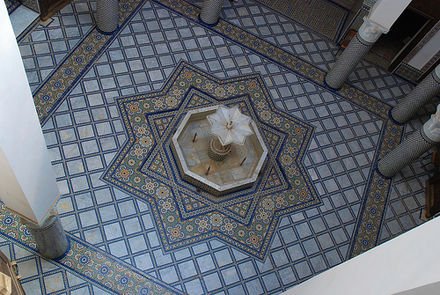
The symbol is used as a marker for the end of a chapter in Arabic calligraphy. It's a relatively obscure symbol in Islam. The symbolic interpretation can be a bit esoteric and harder to understand but it's worth noting.
What we have here is a flower or circle within an eight pointed star. When the ends of the points are connected around the perimeter it forms an octagon. Octagons have been traditionally associated with dominance and control. The symbol plays a role in our society with big red octagons at street corners controlling traffic.
The flower of course is an old symbol representing fertility and the circle as mentioned before can represent the sun or the moon. Although, with its curved perimeter, a circle is most often seen as a feminine symbol whereas the male is denoted with something like a triangle with its straight lines and hard angles.
So once again we have a feminine symbol encapsulated within a control structure in a submissive role.
Symbol # 5: Scimitar

Early examples go back to the 9th century but became widespread during the Ottoman Period. The curved design allows efficient slashing.
As we've seen, the crescent is a lunar or feminine symbol. The scimitar has been used for more than a millennia to spread the Islamic caliphate. In this case, they killed people with a fertility symbol. For this reason, the scimitar may be the most negative symbol in Islam.
-----------------------------------------------------------------------------------------------------------------------------------
This information just scratches the surface of symbolism. There are many extensive resources online if you'd like to learn more. It's an interesting topic albeit a heady one open to multiple interpretations, but I feel an important one nonetheless.
-Brian
-----------------------------------------------------------------------------------------------------------------------------------
References:
http://www.middleeasteye.net/news/crime-and-punishment-islamic-state-vs-saudi-arabia-1588245666
http://www.meforum.org/2646/worldwide-trends-in-honor-killings
http://www.mindbodygreen.com/0-17614/how-to-sync-your-menstrual-cycle-with-the-moon.html
http://www.drnorthrup.com/wisdom-of-menstrual-cycle/
http://www.epigee.org/menstruation_lunar_fertility.html
http://www.todayifoundout.com/index.php/2015/05/origin-male-female-symbols/
http://www.lionpath.net/zwoelf.html
https://en.wikipedia.org/wiki/Rub_el_Hizb
https://en.wikipedia.org/wiki/Jizya
https://en.wikipedia.org/wiki/Mosque
https://en.wikipedia.org/wiki/Scimitar
Following and upvoted. :)
Downvoting a post can decrease pending rewards and make it less visible. Common reasons:
Submit